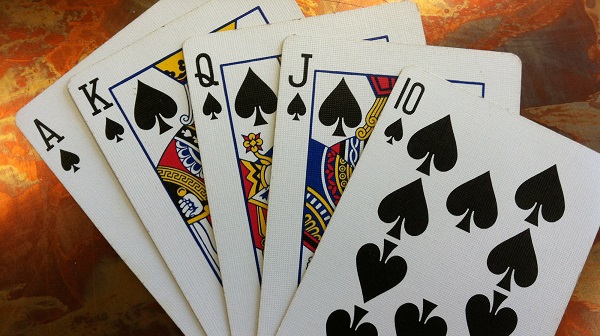Playing flush draws is a challenge for even the most experienced player.
If you play poker for more than an hour, you’ll no doubt find yourself in a situation where you hold four cards to a flush on the flop. The reason this draw is frustrating is that so many ways of playing it exist.
Flush Draw Dangers
You know you’re becoming a mature poker player when you start recognizing dangerous situations and wanting to learn how to get away from them. Flush draws are responsible for a common and potentially very dangerous situation.
The biggest danger in a flush draw is the fact that poor players tend to focus on drawing to that flush to the detriment of their overall hand. While this isn’t such a big deal in Texas holdem, drawing to non-nut hands in Omaha is a quick way to lose your stack.
The Flush Draw in Texas Holdem
For an example of how this can happen in Texas holdem, picture this:
You hold the queen and jack of diamonds and the flop reveals an ace of spades, and the three and seven of diamonds. Yep, you’ve got it – you hold four to a flush.
Because of what you hold, no doubt you’re behind at this point in the hand. Against just a few opponents, hitting that flush will increase your odds of winning. But at a larger table, you need to be aware that you’re holding a pretty weak flush, even if you do manage to hit it. An ace or king high flush will still beat you, and the more opponents at the table, the more likely this occurrence.
The more opponents you are playing against in the hand, the higher the possibility that one of them will have a better flush.
If you make your flush on the turn, it opens up a new opportunity for one of your opponents to draw out on you. One of them may have the ace or king of diamonds with an off suit card. If another diamond lands on the river they will beat you.
Another dangerous situation for flush draws in holdem – when the board pairs. Any time the board pairs it is possible for one of your opponents to hold a full house. Just like drawing to the third best flush, the odds of an opponent holding a full house goes up as the number of opponents goes up.
In Texas holdem you shouldn’t fold every time the board pairs or you don’t have the nut flush, but you do need to be aware that you can lose these hands. The bad thing is that when you do lose them they tend to be big pots.
If you are playing Omaha you need to avoid chasing these types of hands outright because second and third best hands lose a great deal of money in the long run.
How to Play Flush Draws Perfectly
Flush draws tend to play best if you have just a few opponents and average-sized pots. The pot should hold enough to justify the chase, but not so much that the chase is too risky.
Lots of players in low level games chase flushes with as few as two cards. Learning to focus on nut-flushes when appropriate will automatically ramp up your game.
Take note – flush draws are difficult to camouflage, since everyone sees the two to a flush on the board. Your opponents can also see when the third suited card hits the board. As soon as this happens everyone is either thinking that an opponent has hit a flush or they are happy that they hit their flush. This can create a good bluffing opportunity. But if you bluff and are called or raised you need to get out of the hand immediately.
Suited Starting Hand Guidelines
Picking the correct starting hands in Texas holdem depends on your position, the playing ability of your opponents, your own playing ability, and how deep the stacks are around the table.
Because of these things, this is a set of general guidelines for hands to consider playing, not specific advice.
Suited hands with an ace and ten or higher (AK, AQ, AJ, AT) can be played in most games profitably.
You have the chance to hit ace high flushes as well as straights and high two pair hands.
Large suited connectors, like king queen, king jack and queen jack can also play well in many games.
The next level of hands include suited aces with cards five or below and other suited connectors.
These hands give you both flush and straight possibilities, but they are weaker than the first group of hands.
The worst hands tend to be suited aces with a six, seven, eight or nine.
The reason these hands are dangerous is because the only great hand you can hit is the flush. You will have hands where you hit top pair, but your kicker is so bad that you will probably lose money in the long run. Most professional players fold hands like these in all but the loosest of games.
Conclusion
Part of becoming a winning poker player involves knowing when to get out of a bad situation and when it pays to ride a situation out. You get into most bad situations by playing second tier and worse starting hands. As you learn when to get out of bad situations you can actually play more hands.
If you draw to the best flushes and learn to play them the right way, playing flush draws can add a great deal of money to your long term profit. Learn to avoid trap hands and how to maximize the pots when you do hit your draws.

 MENU
MENU















